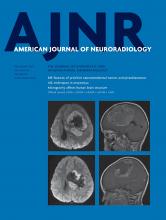Abstract
BACKGROUND AND PURPOSE: Unruptured intracranial vertebrobasilar dissecting aneurysms with brain stem compression are difficult to treat. In the present study, the clinical and radiologic outcomes of unruptured intracranial vertebrobasilar dissecting aneurysms with brain stem compression based on different treatment modalities were evaluated.
MATERIALS AND METHODS: This study included 28 patients with unruptured intracranial vertebrobasilar dissecting aneurysms with brain stem compression treated from January 2009 to December 2017. Treatment methods were observation (n = 6), stent-assisted coil embolization (n = 9), parent artery occlusion (n = 6), and flow diversion (n = 7). The data of baseline characteristics, change of aneurysm size, retreatment rate, stroke occurrence, and alteration of the mRS score were obtained from retrospective chart review.
RESULTS: The initial size of dissecting aneurysms was largest in the flow diversion group (22.5 ± 7.7 mm), followed by parent artery occlusion (20.3 ± 8.4 mm), stent-assisted coil embolization (11.7 ± 2.2 mm), and observation (17.8 ± 5.5 mm; P = .01) groups. The reduction rate of aneurysm size was highest in the parent artery occlusion group (26.7 ± 32.1%), followed by flow diversion (14.1% ± 28.7%), stent-assisted coil embolization (−17.9 ± 30.3%), and observation (−31.5 ± 30.8%; P = .007) groups. Additional treatment was needed in the observation (4/6, 66.7%) and stent-assisted coil embolization (3/9, 33.3%; P = .017) groups. Improvement of the mRS score on follow-up was observed in the flow diversion (6/7, 85.7%) and parent artery occlusion (4/6, 66.7%) groups but not in the stent-assisted coil embolization and observation groups. A worsened mRS score was most common in the observation group (4/6, 66.7%), followed by stent-assisted coil embolization (3/9, 33.3%), parent artery occlusion (2/6, 33.3%), and flow diversion (0/7, 0%) groups.
CONCLUSIONS: When treating intracranial vertebrobasilar dissecting aneurysms with brain stem compression, parent artery occlusion and flow diversion should be considered to reduce aneurysm size and improve the mRS score.
ABBREVIATIONS:
- FD
- flow diversion
- IVBDA
- intracranial vertebrobasilar dissecting aneurysm
- PAO
- parent artery occlusion
- SACE
- stent-assisted coil embolization
- © 2019 by American Journal of Neuroradiology












